How to Stock Your First Kitchen
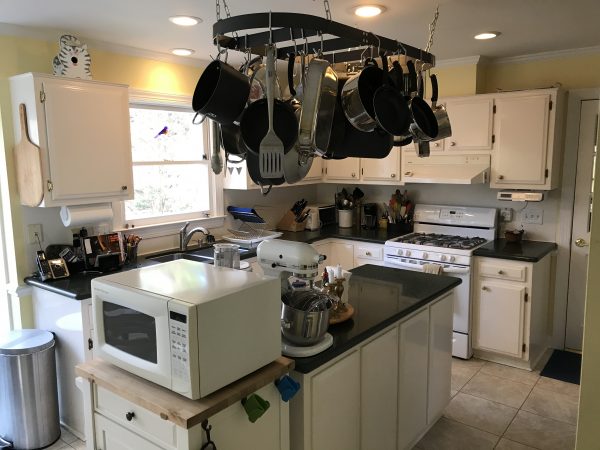
My kitchen. (All photos courtesy of the author.)
Most personal finance blogs will tell you that cutting down on eating out is one of the best ways to improve both your monthly cashflow and your health. If you are newly living on your own, you need to set up your kitchen in a way that’s affordable but won’t continually frustrate your attempts to cook. It’s a baffling problem, especially if you haven’t cooked much in the past. Much of the internet is no help; many guides assume either a ridiculous budget (“Our bargain pick for knives is a true gem at only $300 for the set!”) or make lofty promises on what you can do (“How to Cook Anything With a Coffee Can and a KFC Spork!”).
I’m going to try and strike a balance between the two, with a kitchen that will enable you to cook a wide variety of foods without breaking the bank. My mother made sure my siblings and I cooked while growing up, and although I’ve been living on my own for nearly 20 years, I still remember how annoying it was to set up that first apartment kitchen.
Feel free to ignore or add to any part of this guide; the Billfold Police will not show up at your door if you splurge on some of the items or skip others. Be aware that the photos are of my current kitchen and contain more tools and implements than a starter kitchen needs — though you may find that you want to add to your kitchen once you get started! Make it your own: a kitchen is almost as intensely personal as your favorite color or how firm you like your pillow.
General notes
It’s easy to spend a huge amount of money on kitchen equipment and then realize you don’t have the right tools — maybe you bought stuff you never use, and maybe you bought budget versions of items that don’t function as well as you’d like. (Ask me how I know!) How do you balance the need for decent kitchenware with the fact that you aren’t made of money? It’s a tricky problem.
Here’s my philosophy on the matter: Having [tool, utensil, etc.] gives you the ability to cook things you cannot cook otherwise. Increasing the quality of [thing] will either help it last longer and/or help you to cook better or easier. But food prepared with even “value” equipment will almost certainly be perfectly acceptable. I prioritize having the variety of tools I need over buying the fanciest versions of fewer things.
With that in mind, try buying lower-end stuff to start. If you find you are using a particular tool often, you can get the nicer version when the first one wears out.
Ikea, Walmart, and Target are good places to buy the basics. Bed Bath & Beyond has higher-quality stuff, but they can be pricey. (Never shop there without a stack of coupons!) I love to cook, but the only time I shop at Sur La Table or Williams Sonoma is when I have a gift card; it’s just too much money for a bump in quality I don’t feel I need.
Cookbooks
If you are just getting started, I highly recommend finding a basic, broad, and reliable cookbook to help you out with the basics. For me, it was How to Cook Everything by Mark Bittman, for Mom, it was the Betty Crocker Cookbook. Your first cookbook should not be anything fancy or “gourmet;” just basic cooking using easily-available ingredients. This will introduce you to cooking a wide variety of dishes.
If you want to learn to hate cooking very quickly, source random recipes from the internet. Even when they don’t contain outright mistakes or leave out important steps, amateur recipe writers are not familiar enough with how home kitchens, equipment, and ingredients can vary, and fail to account for that in the recipes. (This is huge problem when you’re baking.)
My go-to source for when I want to cook something fancy is my complete set of Cook’s Illustrated Annuals, which go back to 1993. You could do a lot worse than a subscription to their website.
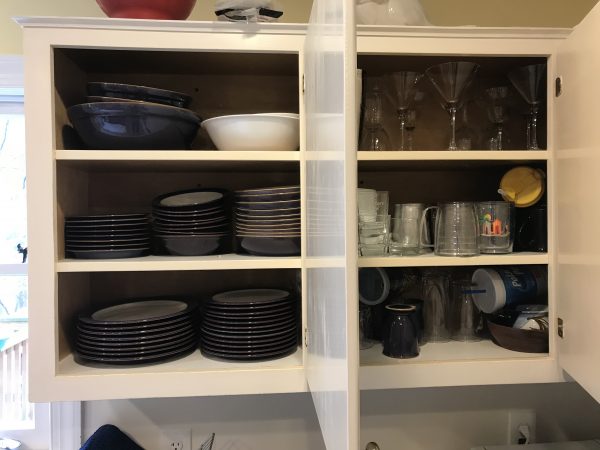
Dishes
Even if you are single, you should have a complete dining service for four. Everybody usually has company over at some point. For me, a “service” means small, medium, and large plates, and small bowls, cereal bowls, and salad bowls.
As far as what to get for plates and bowls? I recommend Corelle. It’s compact, light, doesn’t wear out, and is almost indestructible. If you can find a set on Craigslist, at a thrift store, or at a garage sale, it’ll also be quite cheap. But what you get is definitely a matter of taste. (That’s mostly not Corelle in the photos; my wife wanted something fancier when we got married.)
For glasses, get whatever. Totally makes no difference at all. They generally aren’t used in cooking, so just get as many as you need to last you between washing dishes.
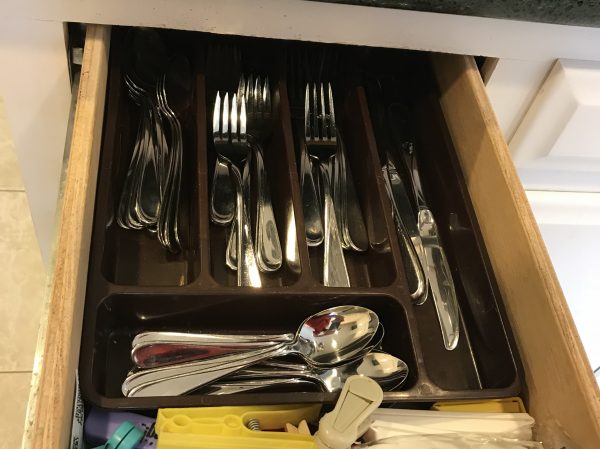
Flatware
I’d get at least as many complete services as you have dishes. (In this case a “service” is a knife, dinner fork, dessert fork, teaspoon, and soup spoon.) You’ll probably want extra teaspoons and dinner forks, as they get used often outside of meals. Many patterns are not “open stock”, so you’ll probably have to purchase your flatware in sets. Get whatever pattern catches your fancy and doesn’t feel too flimsy, and again, thrift stores and garage sales can be a big help here. I’m still using some Oneida flatware I got 20 years ago from a housewares store. You’ll also want a couple serving spoons. Get a flatware sorter so your silverware drawer isn’t a jumbled mess.
Prep and serving dishes
While I no longer regularly use my Corelle dishes, I kept the serving bowls and small bowls and make heavy use of them. The small bowls hold little ingredients (spices, an egg yolk or two, etc.), and the serving bowls get used for ersatz mixing bowls and bulkier ingredients. (They also get used to serve food.) Even though it’s just my wife and myself at home, I have a dozen of those small bowls and three each of the 1-quart and 2-quart serving bowls. These don’t have to match your dishes or anything, but they will make your life a lot easier.
You’ll also need some actual mixing bowls. These are different from serving bowls in that they have steep, high, sides. Just about anything that catches your fancy will work; mine are glass; they are heavy as heck, and I could theoretically put them in the oven (though I’ve never tried). On the plus side, they don’t slide around the counter so much when I’m using my hand mixer.
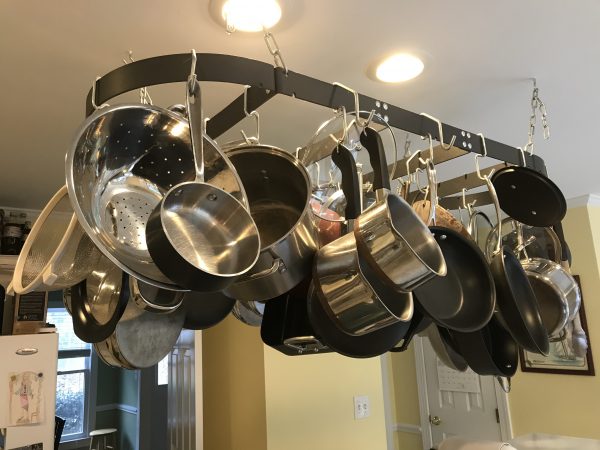
Pots and pans
Nearly any type of pot or pan will work; as long as it’s not so thin it’ll dent if you treat it a little rough, it’ll do acceptably well. (Seriously, one of my favorite pans is literally the cheapest 8” skillet I could find when my “good” pan was mailed off for warranty replacement.)
Aluminum? Stainless steel? Enameled cast-iron? Carbon steel? Plain cast iron? You’ll find cooks that swear by each one. As you can see from the picture above, I have a haphazard mix of all of them. My view? Get something you can afford, and get cooking.
Whatever you choose, I suggest starting out with Teflon non-stick for nearly everything, especially if you are a novice cook. Few things are more frustrating for a beginning cook than food gluing itself to your pan/pot. The pots/pans you buy should be oven-safe (up to 450 Fahrenheit should be more than enough, unless you want to broil); this should be marked on the label.
Now, what you’ll need:
- An 8”, 10”, and 12” skillet. If you are getting just one 12” skillet, get a deep one; it’s sometimes referred to as a 5-quart saute pan. Lots of “one dish meal” recipes require one of those. Bonus points if your skillets nest for compact storage. You’ll also need a lid; I have a “universal” lid that fits a bunch of different skillets that’s made out of nothing more than painted sheet metal with a knob on top.
- Saucepans. Common sizes are 1 ½-quart and 2 ½-quart. That’s a good start. You also need lids for those.
- A big pot. A 5-quart pot with lid will be fine to get you started. You can’t cook crab legs or a ginormous pot of stock in one, but that’s a can you can kick down the proverbial road.
- A roasting pan. Lots of choices here; it’s nice if it’s one you can use on the stove also, but this is not vital.
My first set was a $120 Ecko non-stick set from Walmart (three skillets, two saucepans, and a 5-quart pot); every single one is still in frequent use, although the coating is starting to flake off of a couple of them (it’s harmless).
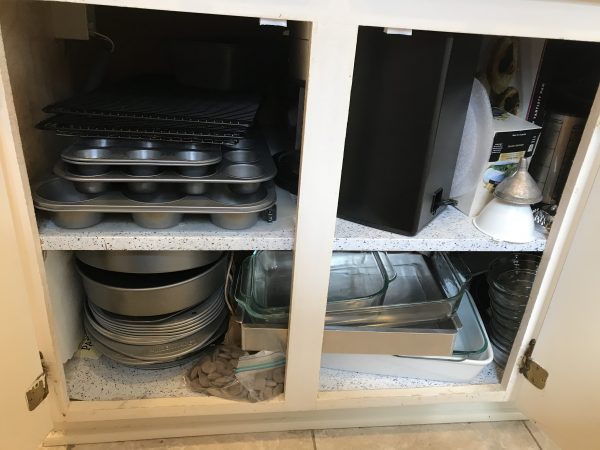
Bakeware
Even if you don’t plan on baking things like bread or cake, I’d get an 8×8, 7×10, and 9×13 glass baking dish; many oven-based recipes will expect you to have these pans. You’ll also need a couple rimmed baking sheets; I’m still using, many years later, some cheap non-stick ones from Walmart. If you want to get fancy, an uncoated “half sheet pan” from a restaurant supply will be cheap and sturdy, and is the generally accepted professional choice. These rimmed sheets are used for lots of tasks, from roasting veggies and baking cookies to acting as a drip tray to go underneath those Pyrex pans.
If you do plan on baking, you’ll need whatever pans are called for by those recipes: loaf, cake, muffin, whatever. Loaf pans come in two sizes, so get a pair of each. For cake pans, make sure you get a set of three in whatever size, since three-layer cakes are not unheard of. The cheap non-stick pans work just fine.
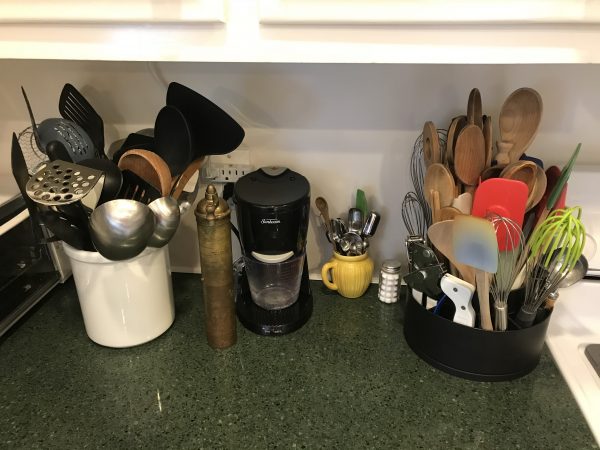
Cooking utensils
You… errr… don’t need this many cooking utensils. I got spatulas and spoons as stocking stuffers so often that my wife forbade my family to get me any more; they then thought of creative ways to get around the ban. (“You didn’t say anything about whisks!” “This is called a Spurtle!” “Here’s a Spoonula!”) She then decreed I could simply have no additional places to put them. Boooo!
- My primary cooking utensil is the humble wooden spoon. They are cheap, don’t melt, don’t scratch and can last for generations. You’ll also need a couple small and couple large heatproof flexible spatulas. That should cover all your stirring needs.
- A medium and large wire whisk are essential; if you can find one for a reasonable price, a coated or nylon whisk will be nice if you have the need to whisk something in a non-stick pan.
- You’ll also need a couple “turning” spatulas (the broad, thin, and flat type). I use basic nylon ones because so much of my cookware is non-stick.
- A pair of tongs; I have one metal pair and one nylon-tipped pair.
- A ladle.
- A plain spoon and slotted spoon with a decent-sized bowl. (Ladles are cumbersome, and wooden spoons, for all their merits, don’t usually have deep bowls.)
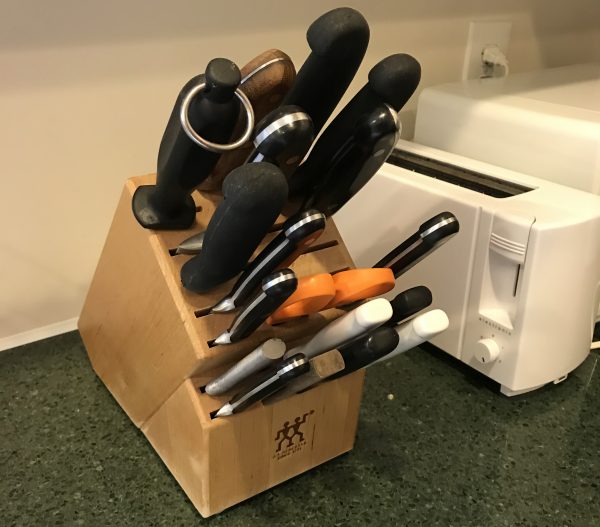
Knives
Wow. Buying knives is confusing, error-prone, and complicated. As you can see, I have a broad assortment of brands. There exist cheap knives that are perfectly fine and expensive knives that are terrible. I suggest finding a local commercial restaurant supply store, going there, and asking for a basic cheap knife set. The Victorinox Fibrox series used to be cheap and amazingly good (and common in actual commercial kitchens); they are still good, but the secret’s out and they aren’t so cheap any more.
In my photo, the big black-handled ones are Victorinox Fibrox, the black-and-silver are Tramontina (Walmart; my first knife set), plus orange Fiskars kitchen shears, a couple random paring knives, a “tomato knife” with a fine serrated blade, a generic bread knife, and really cheap steak knives to fill the rest of the slots. The knife block came from a garage sale; I don’t actually own any Henkels.
You’ll likely want an 8” chef’s knife, a 6” utility knife, a couple of paring knives, and (if you eat fresh bread) a bread knife. You need a steel for relatively-frequent touching up (I steel most knives after about a half-week of use for a given knife) and you also need to take your knives to be sharpened when the steel stops working. All your cooking knives should have a straight edge except for the bread knife, which will be serrated. You’ll also need a pair of kitchen shears; mine pull apart at the joint for easy cleaning.
If you buy used knives, I strongly suggest having them professionally sharpened; a dull blade is a dangerous blade.
You’ll also probably want a knife block; many sets come with them. Lastly, if you eat steak or chops, get enough steak knives as you have seats at your table; you can really cheap out here, because it’s not expensive or difficult to make a usable serrated steak knife. (When we met, my wife had awful knives; the only ones we kept were the steak knives, which work fine.)
Cutting boards
You need at least three cutting boards unless you are a vegetarian: one for raw poultry, one for other meats, and one for everything else. If raw poultry has touched a cutting board, it needs to go right in the sink afterwards, as you can’t use it for anything else until it’s been thoroughly cleaned. Inexpensive wood or plastic boards will be fine to start. I suggest a couple smaller boards for everyday small chopping/cutting tasks, and a couple large ones for bigger jobs.
Appliances
- Okay, I’m assuming you have a stove, oven, and fridge already. I’m not going to go into my preferences, because if you are setting up your first kitchen, you are just using whatever the landlord or previous homeowner supplied.
- Microwave. I don’t want to imagine not having one. It’s especially handy for reheating leftovers; if you are trying to save money AND time, you’ll probably be making a lot of recipes with leftovers. (Most recipes serve 4–6 people.)
- Food processor. I suggest a garage sale or something for your first one. This is one of those appliances that will save you a ridiculous amount of time when you use it.
- Mixer. If you never bake, you can probably do without one. If you bake occasionally, get a hand mixer (the only caution I have is to make sure you get one with wire beaters, not the kind with a post running down the center; those are a pain to clean). If you bake often, you’ll probably want a stand mixer. Save your pennies or watch garage sales to get a KitchenAid; there’s no substitute.
- Toaster oven. This is totally optional, but I find I use mine a lot for heating plates (cold plates + hot food = meh). It’s also handy for oven-heating small amounts of food, especially during the summer when the full oven would heat the kitchen. And it makes toast!
- Food-specific appliances. I’m talking about your toasters, waffle irons, coffee makers, espresso makers, water kettles, sandwich press, bread maker, Keurig, etc. Keep an eye on your counter space when buying small appliances. I mean, if you want homemade waffles (I do!), you gotta have a waffle iron, but these types of purchases can get out-of-hand quickly, both cost and space-wise. (Please don’t ask me how many specialty appliances I have!)
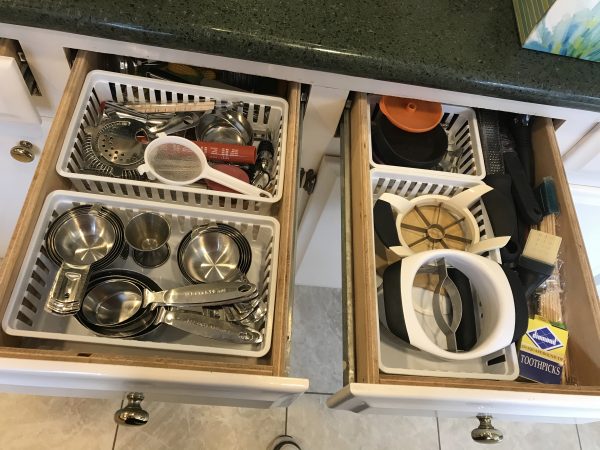
Measuring equipment
- Measuring spoons. I suggest two sets of stainless-steel spoons. They are simply less clumsy than plastic. You might want to keep an eye out for a set that fits well in spice jars.
- Dry measuring cups. The material isn’t important here, but get at least two sets.
- Liquid measuring cups. It’s hard to go wrong with the ubiquitous glass ones. Get 1, 2, and 4-cup measurements. You will often be handling boiling liquids with these, so avoid plastic.
- Food scale. A cheap digital scale from Amazon is fine.
- Thermometer. A quick-read digital thermometer will get you started. My go-to thermometer is one I can leave in food with a wire snaking out of the oven so it’ll beep at me when things are done.
Misc. stuff that’s easy to forget:
- Trash can. If you are starved for floor space, a small cabinet-sized one will have to do. Otherwise, get a step can. The steel trash can in the photo at the beginning of this article is fifteen years old now, and it’s just a basic can from a housewares store.
- Apron. Cooking makes for spatters and drips, so protect your clothes. I also love the convenience of wiping my hands on something I don’t care about getting grease/flour/batter/etc. all over.
- Can opener. I’m still using a Swing-A-Way hand-held can opener I got when I set up my apartment all those years ago. (Note: the current Swing-A-Way can openers are now made in China; the original is sold under the EZ Duz It brand.) Avoid the really cheap ones made out of stamped and twisted steel.
- Airtight bulk containers for flour and sugar. I have a 5-quart container for flour and a 3-quart one for sugar.
- Bag clips/clamps. I have a dozen in constant use to cut down on the number of bulk containers I need.
- A “church-key.” Use this to open bottles and to cut those triangles out of cans you want to pour from. (Also handy for popping the vacuum seal on jars!) Mine just attaches to a magnet on the fridge.
- Corkscrew. I suggest the “waiter’s corkscrew”/”wine key” type.
- Ice cream scoop.
- Salt shaker. I have one with a couple small holes for the table, and another one with lots of larger holes for beside the stove.
- Pepper grinder. Treat yourself to fresh-ground pepper. I prefer the kind with a crank; it’s faster than the kind you twist.
- Steamer basket.
- Vegetable peeler. I use an Oxo Good Grips, but even the cheap ones will work acceptably well.
- Oven mitts. I rarely use pot-holders because I have a pair of thick cotton oven mitts I really like.
- Colander. Indispensable. You’ll use it for washing veggies, draining pasta, etc. Make sure you get one that will be stable when you are dumping a pot full of pasta and boiling water into it.
- Mesh strainer. Get one with stainless-steel mesh and a sturdy handle.
- Trivets. Assuming there are non-heat-proof counters or tables in your place, you need something to set hot dishes on. The ones I use most are from a 3-pack of cork trivets I got from Ikea a long time ago.
- Utensil crocks. Just a little something (empty cans, sturdy vases, whatever) to hold your utensils (wooden spoons, spatulas, etc.) and a smaller one for your measuring spoons. Keeping those right next to the stove is way handier than rooting around in a drawer.
- Sink stopper/strainer. Don’t rely on a garbage disposal, even if you have one. It’s not good for your pipes, it’s not good for the sewage system, and it’s not good for the environment.
- Box grater. Even if you have a food processor, there are things your food processor can’t actually process well (soft cheese) and times when you won’t want to get that large thing dirty.
- Spice rack. In the pantry section below I suggest you get a pre-loaded spice rack, but you are also going to need an empty one for all the spices and flavorings your pre-loaded rack doesn’t include. You can see in the photo that I have a couple of double-decker turntables.
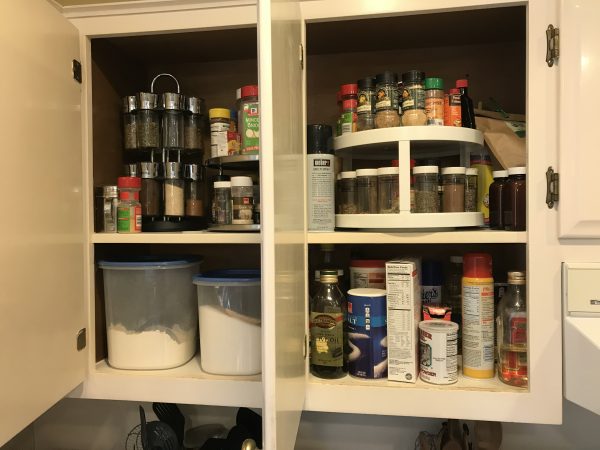
Pantry
I’m not going to tell you how to stock your pantry. What do you like to eat? How much space do you have? I can say that you should expect your first few grocery bills to be hefty while you stock up on pantry staples. The only thing I’ll suggest is to go out of your way to buy is one of those pre-loaded spice racks. Buying spices one bottle at a time is expensive. Those pre-filled spice racks don’t necessarily have the highest-quality or freshest spices (and you are inevitably going to need spices it doesn’t include), but the rack is handy, and they are certainly a heck of a lot cheaper than buying 20 of those overpriced little jars from the grocery store. A good source of spices when you need to stock up is Dollar Tree. While they don’t have every spice you need (given the price constraints), they will certainly have the best prices on the spices they do stock.
Cleaning stuff
This is an often-neglected part of the kitchen, but it’s important to do well. What you’ll need:
- Dish gloves. Gloves let you work with hotter water than you could otherwise, and keep the soap from drying your hands out. If you are a man, you may very well have to get gloves from the hardware store, because grocery stores appear to think men never do dishes, and don’t always stock gloves that fit.
- Soap dispenser. Dollar Tree again! They’ll sell you the initial bottle for $1, and will sell you quart-sized refills for another $1.
- Scrubby-thing. Even with non-stick cookware, you’ll still need to scrub occasionally, and you don’t want to scratch things; that means NO SCOTCH-BRITE. The 3M “Dobie” is something we used for a while. We now use a “Peach Pit Scrubber” from Amazon; the thing lasts forever, isn’t easily cut by knives, and is gentle on cookware.
- Dishcloths. I get these at the grocery store; they are a cotton washcloth on one side, and a gently-scrubby nylon mesh on the other. (Do not buy cellulose sponges! These are now known to be a notorious cesspool of germy grossness unless you sterilize them multiple times per week. Dishcloths dry nicely between uses, and can just be tossed in the washing machine.)
- Dish towels. Just basic terry cotton dish towels are fine; they are cheap and available everywhere. I’ve had mixed luck with microfiber (some are not very absorbent).
- Dish drainer. It’s surprisingly hard to find a good one. I guess find one that looks attractive to you and has a way to drain the dripped-away water back into your sink.
- Sturdy spray bottle. I got one of these from the janitorial section of Home Depot. I keep it filled with a mixture of water and Mr. Clean at 1-ounce concentrate per quart. This is a lot cheaper than buying flimsy non-refillable 20-ounce bottles of all-purpose cleaner from the supermarket.
- If you have a smoothtop stove, you’ll need a bottle of smoothtop cleaner.
- Paper towel dispenser. I use one of those under-cabinet plastic ones; works just fine.
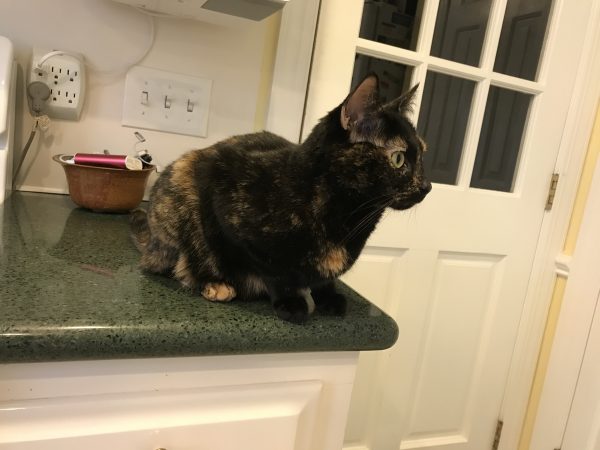
Conclusion
Lastly, you need a cat. Because cat hair makes everything taste better! (And a picture of a cute cat makes every blog post better!)
Seriously, in conclusion, I hope you’ve found this long article useful if you are setting up a new house or apartment. I don’t expect everybody to take this list, run to Target, and plonk down $$$ all at once — but if you have just moved into a new place and are faced with a bunch of empty cabinets, I hope this helps you figure out what you want. Nobody wants to start making dinner only to realize “Shoot! I can’t make [X] because I forgot I need [Y]!” I also hope this prevents you from looking at your cluttered countertop and empty bank account, asking yourself why on earth you bought a bread machine, pizza baker, and three drawers of strange kitchen gadgets that you didn’t really need.
Peter Mescher is an IT Architect living in North Carolina who was probably a ham-handed line cook in a past life. Look for him in the comments section of Quality Blogs Everywhere as “SirWired.”
Support The Billfold
The Billfold continues to exist thanks to support from our readers. Help us continue to do our work by making a monthly pledge on Patreon or a one-time-only contribution through PayPal.
Comments